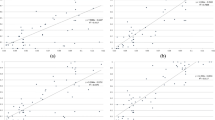Summary
The development of linkage maps with large numbers of molecular markers has stimulated the search for methods to map genes involved in quantitative traits (QTLs). A promising method, proposed by Lander and Botstein (1989), employs pairs of neighbouring markers to obtain maximum linkage information about the presence of a QTL within the enclosed chromosomal segment. In this paper the accuracy of this method was investigated by computer simulation. The results show that there is a reasonable probability of detecting QTLs that explain at least 5% of the total variance. For this purpose a minimum population of 200 backcross or F2 individuals is necessary. Both the number of individuals and the relative size of the genotypic effect of the QTL are important factors determining the mapping precision. On the average, a QTL with 5% or 10% explained variance is mapped on an interval of 40 or 20 centiMorgans, respectively. Of course, QTLs with a larger genotypic effect will be located more precisely. It must be noted, however, that the interval length is rather variable.
Similar content being viewed by others
References
Dempster AP, Laird NM, Rubin DB (1977) Maximum likelihood from incomplete data via the EM algorithm. J R Statist Soc Ser B 39:1–38
Falconer DS (1981) Introduction to quantitative genetics, 2nd edn. Longman, London
Helentjaris T (1987) A genetic map for maize based on RFLPs. Trends Genet 3:217–221
Jansen J (1991) Fitting regression models to ordinal data. Biom J 33:807–815
Jensen J (1989) Estimation of recombination parameters between a quantitative trait locus (QTL) and two marker gene loci. Theor Appl Genet 78:613–618
Keim P, Diers BW, Olson TC, Shoemaker RC (1990) RFLP mapping in soybean: association between marker loci and variation in quantitative traits. Genetics 126:735–742
Knapp SJ, Bridges WC, Birkes D (1990) Mapping quantitative trait loci using molecular marker linkage maps. Theor Appl Genet 79:583–592
Lander ES, Botstein D (1989) Mapping Mendelian factors underlying quantitative traits using RFLP linkage maps. Genetics 121:185–199
Luo ZW, Kearsey MJ (1989) Maximum likelihood estimation of linkage between a marker gene and a quantitative trait locus. Heredity 63:401–408
McLachlan GJ, Basford KE (1988) Mixture models: inference and applications to clustering. Marcel Dekker, New York
O'Brien SJ (ed) (1990) Genetic maps, 5th edn. Cold Spring Harbor Laboratory Press, New York
Ooijen JW van (1989) The predictive value of estimates of quantitative genetic parameters in breeding of autogamous crops. PhD-thesis, Agricultural University, Wageningen
Paterson AH, Lander ES, Hewitt JD, Peterson S, Lincoln SE, Tanksley SD (1988) Resolution of quantitative traits into Mendelian factors by using a complete linkage map of restriction fragment length polymorphisms. Nature 335:721–726
Paterson AH, DeVerna JW, Lanini B, Tanksley SD (1990) Fine mapping of quantitative trait loci using selected overlapping recombinant chromosomes, in an interspecies cross of tomato. Genetics 124:735–742
Paterson AH, Damon S, Hewitt JD, Zamir D, Rabinowitch HD, Lincoln SE, Lander ES, Tanksley SD (1991) Mendelian factors underlying quantitative traits in tomato: comparison across species, generations, and environments. Genetics 127: 181–197
Sax K (1923) The association of size differences with seed-coat pattern and pigmentation in Phaseolus vulgaris. Genetics 8:552–560
Thoday JM (1961) Location of polygenes. Nature 191:368–370
Titteringon DM, Smith AFM, Makov UE (1985) Statistical analysis of finite mixture distributions. Wiley, New York
Weller JI (1986) Maximum likelihood techniques for the mapping and analysis of quantitative trait loci with the aid of genetic markers. Biometrics 42:627–640
Welsh J, McClelland M (1990) Fingerprinting genomes using PCR with arbitrary primers. Nucleic Acids Res 18:7213–7218
Williams JGK, Kubelik AR, Livak KJ, Rafalski JA, Tingey SV (1990) DNA polymorphisms amplified by arbitrary primers are useful as genetic markers. Nucleic Acids Res 18:6531–6535
Zamir D, Tanksley SD (1988) Tomato genome is comprised largely of fast-evolving, low copy-number sequences. Mol Gen Genet 213:254–2617
Author information
Authors and Affiliations
Additional information
Communicated by J. W. Snape
Rights and permissions
About this article
Cite this article
van Ooijen, J.W. Accuracy of mapping quantitative trait loci in autogamous species. Theoret. Appl. Genetics 84, 803–811 (1992). https://doi.org/10.1007/BF00227388
Received:
Accepted:
Issue Date:
DOI: https://doi.org/10.1007/BF00227388




